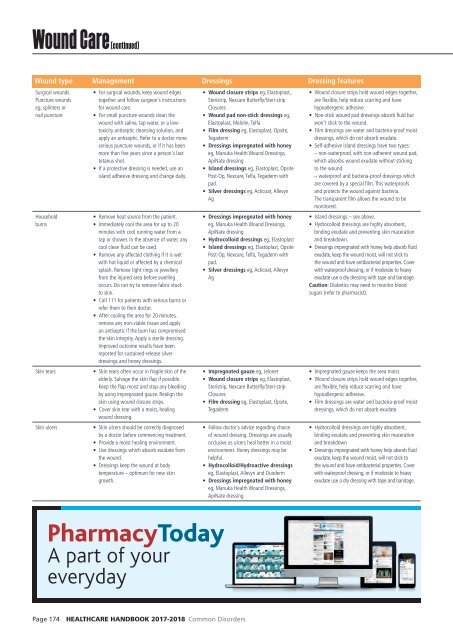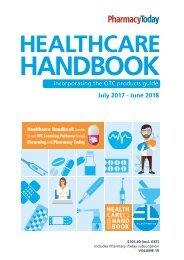2017 HCHB_digital
You also want an ePaper? Increase the reach of your titles
YUMPU automatically turns print PDFs into web optimized ePapers that Google loves.
Wound Care (continued)<br />
Wound type Management Dressings Dressing features<br />
Surgical wounds<br />
Puncture wounds<br />
eg, splinters or<br />
nail puncture<br />
Household<br />
burns<br />
Skin tears<br />
Skin ulcers<br />
• For surgical wounds, keep wound edges<br />
together and follow surgeon's instructions<br />
for wound care.<br />
• For small puncture wounds clean the<br />
wound with saline, tap water, or a lowtoxicity<br />
antiseptic cleansing solution, and<br />
apply an antiseptic. Refer to a doctor more<br />
serious puncture wounds, or if it has been<br />
more than five years since a person's last<br />
tetanus shot.<br />
• If a protective dressing is needed, use an<br />
island adhesive dressing and change daily.<br />
• Remove heat source from the patient.<br />
• Immediately cool the area for up to 20<br />
minutes with cool running water from a<br />
tap or shower. In the absence of water, any<br />
cool clean fluid can be used.<br />
• Remove any affected clothing if it is wet<br />
with hot liquid or affected by a chemical<br />
splash. Remove tight rings or jewellery<br />
from the injured area before swelling<br />
occurs. Do not try to remove fabric stuck<br />
to skin.<br />
• Call 111 for patients with serious burns or<br />
refer them to their doctor.<br />
• After cooling the area for 20 minutes,<br />
remove any non-viable tissue and apply<br />
an antiseptic if the burn has compromised<br />
the skin integrity. Apply a sterile dressing.<br />
Improved outcome results have been<br />
reported for sustained-release silver<br />
dressings and honey dressings.<br />
• Skin tears often occur in fragile skin of the<br />
elderly. Salvage the skin flap if possible.<br />
Keep the flap moist and stop any bleeding<br />
by using impregnated gauze. Realign the<br />
skin using wound closure strips.<br />
• Cover skin tear with a moist, healing<br />
wound dressing.<br />
• Skin ulcers should be correctly diagnosed<br />
by a doctor before commencing treatment.<br />
• Provide a moist healing environment.<br />
• Use dressings which absorb exudate from<br />
the wound.<br />
• Dressings keep the wound at body<br />
temperature – optimum for new skin<br />
growth.<br />
• Wound closure strips eg, Elastoplast,<br />
Steristrip, Nexcare Butterfly/Steri-strip<br />
Closures<br />
• Wound pad non-stick dressings eg,<br />
Elastoplast, Melolin, Telfa<br />
• Film dressing eg, Elastoplast, Opsite,<br />
Tegaderm<br />
• Dressings impregnated with honey<br />
eg, Manuka Health Wound Dressings,<br />
ApiNate dressing<br />
• Island dressings eg, Elastoplast, Opsite<br />
Post-Op, Nexcare, Telfa, Tegaderm with<br />
pad.<br />
• Silver dressings eg, Acticoat, Allevyn<br />
Ag<br />
• Dressings impregnated with honey<br />
eg, Manuka Health Wound Dressings,<br />
ApiNate dressing<br />
• Hydrocolloid dressings eg, Elastoplast<br />
• Island dressings eg, Elastoplast, Opsite<br />
Post-Op, Nexcare, Telfa, Tegaderm with<br />
pad.<br />
• Silver dressings eg, Acticoat, Allevyn<br />
Ag<br />
• Impregnated gauze eg, Jelonet<br />
• Wound closure strips eg, Elastoplast,<br />
Steristrip, Nexcare Butterfly/Steri-strip<br />
Closures<br />
• Film dressing eg, Elastoplast, Opsite,<br />
Tegaderm<br />
• Follow doctor's advice regarding choice<br />
of wound dressing. Dressings are usually<br />
occlusive as ulcers heal better in a moist<br />
environment. Honey dressings may be<br />
helpful.<br />
• Hydrocolloid/Hydroactive dressings<br />
eg, Elastoplast, Allevyn and Duoderm<br />
• Dressings impregnated with honey<br />
eg, Manuka Health Wound Dressings,<br />
ApiNate dressing<br />
• Wound closure strips hold wound edges together,<br />
are flexible, help reduce scarring and have<br />
hypoallergenic adhesive.<br />
• Non-stick wound pad dressings absorb fluid but<br />
won’t stick to the wound.<br />
• Film dressings are water and bacteria-proof moist<br />
dressings, which do not absorb exudate.<br />
• Self-adhesive island dressings have two types:<br />
– non-waterproof, with non-adherent wound pad,<br />
which absorbs wound exudate without sticking<br />
to the wound.<br />
– waterproof and bacteria-proof dressings which<br />
are covered by a special film. This waterproofs<br />
and protects the wound against bacteria.<br />
The transparent film allows the wound to be<br />
monitored.<br />
• Island dressings – see above.<br />
• Hydrocolloid dressings are highly absorbent,<br />
binding exudate and preventing skin maceration<br />
and breakdown.<br />
• Dressings impregnated with honey help absorb fluid<br />
exudate, keep the wound moist, will not stick to<br />
the wound and have antibacterial properties. Cover<br />
with waterproof dressing, or if moderate to heavy<br />
exudate use a dry dressing with tape and bandage.<br />
Caution: Diabetics may need to monitor blood<br />
sugars (refer to pharmacist).<br />
• Impregnated gauze keeps the area moist.<br />
• Wound closure strips hold wound edges together,<br />
are flexible, help reduce scarring and have<br />
hypoallergenic adhesive.<br />
• Film dressings are water and bacteria-proof moist<br />
dressings, which do not absorb exudate.<br />
• Hydrocolloid dressings are highly absorbent,<br />
binding exudate and preventing skin maceration<br />
and breakdown<br />
• Dressings impregnated with honey help absorb fluid<br />
exudate, keep the wound moist, will not stick to<br />
the wound and have antibacterial properties. Cover<br />
with waterproof dressing, or if moderate to heavy<br />
exudate use a dry dressing with tape and bandage.<br />
PharmacyToday<br />
A part of your<br />
everyday<br />
Page 174 HEALTHCARE HANDBOOK <strong>2017</strong>-2018 Common Disorders



